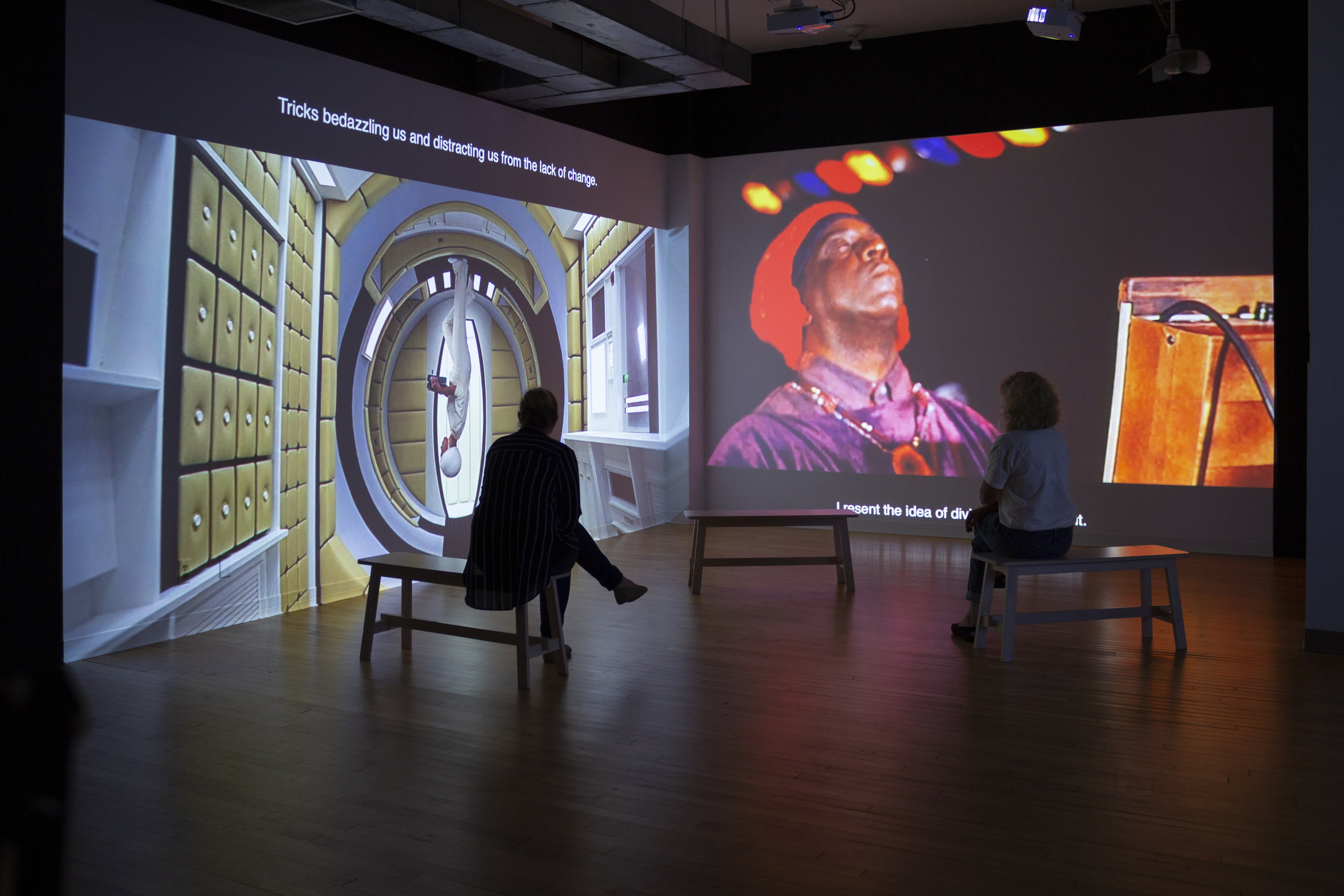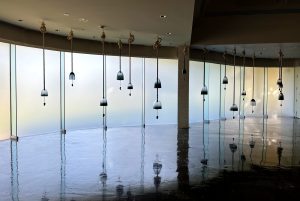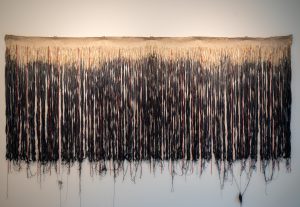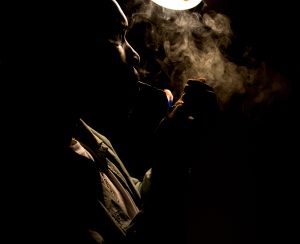“The space of this film is expanding.”
It is indeed. Liza Sylvestre, a recent graduate of University of Illinois Urbana-Champaign (UIUC), captions 2001: A Space Odyssey on a perpendicular wall from Space is the Place, also captioned. These films roll with Sylvestre’s comments and captions coming with them for an interpretation of the two films. How do these two films operate in our culture? Who gets to access them?
This show at the new space, New Genres Art Space, in Rockford, Illinois, is developing programming around digital art, and its ability to be educational, therapeutic, and community-driven. The small gallery space has been used to the max with this exhibition, as these monumental films stretch floor to ceiling. There are captions that don’t match the films. Instead, they describe a separate narrative of the artist’s thoughts and experience watching the movies. I think these captions make the film more approachable highlighting the accessibility of the films.
This interview has been edited for clarity.

Anthony Hamilton: Could you introduce us to your work and the Captioned project?
Liza Sylvestre: My Captioned series, like a lot of my work is a direct connection to actual experience that occurs in my life, formed by the fact that I am a disabled person living in a world that does not consider “abnormal” experiences in its design. Like a lot of people with disabilities or “non-normative” bodies and identities, I am often excluded from situations. I grew up losing my hearing and am now 100% deaf in the medical sense of the word, although not in the cultural sense. I rely on my cochlear implant, and visual cues and context to navigate the audial world.
During my undergraduate studies, my hearing loss was profound, but I had not yet learned how to advocate for myself. Captioning or other accessibility modes were much less common 10+ years ago. It’s sort of a miracle that I didn’t flunk out of school. I was often in situations where I had no access to the information being shared with me. This can happen in several ways [like when] I am unable to follow group conversations because the information moves too fast. As soon as I’ve figured out who is talking, the group has moved on to the next person or idea. I am unable to follow video without captions or subtitles. I remember sitting in one of my art classes, and we were watching a movie—I think it was an episode of Art21—and I had absolutely no clue what was going on because there were no captions. Out of boredom, but also out of my desire to fit in and hide the fact that I had no idea what was going on, I started documenting what I could understand. To anyone else in the class it probably looked like I was taking notes on the film, which I was. But not notes on any of the information shared audibly. I made up stories about people. I described their features. I declared assumptions. I had an entire and complete experience that was separate from any of my classmates’ experiences. Of course, in my Captioned series, I transform these meandering reactions and thoughts into the captioning text that the film lacks. The concept is the result of an activity I’ve been participating in my entire life.
AH: Tell me about Third Space, and the inaugural exhibition at New Genres Art Space. How did you pick these two films: 2001: A Space Odyssey and Space is the Place?
LS: The film selection for Third Space started with 2001: A Space Odyssey. It was chosen, in part, because the supercomputer in the movie’s plot actually comes from the University of Illinois Urbana Champaign, where I went to graduate school. I created Third Space initially for my MFA thesis show at UIUC. I liked the idea of the projected video and a real physical place from the story plot fusing together. The projection literally “touches” the walls of the building, and a new space is created through this gesture.
Space is the Place was chosen to balance the regal qualities of 2001. The two films, in many ways, represent different pillars of our society— high/low culture, white/black, Hollywood/independently produced. But despite all of this they are eerily similar. They both distinctly utilize sound and music, they are both incredibly misogynistic, and they both grapple with imagined futures. The way they are installed in Third Space, with the two films physically touching in the corner of the room, allows viewers to inhabit the space these two films frame and produce. The films are not the same length, so as they play on loops, they are continuously generating new spaces between them. The captions I’ve added to both films are the anchor in the experience. My own disabled voice is the constant that also stitches the two films together, and it also frames the space created for my viewers to inhabit.
Science fiction is a fascinating lens through which to think about the disabled body. Or maybe, more accurately, the disabled body is a fascinating lens through which to think about science fiction. The disabled body is made prosthetic through mobility devices, artificial limbs, hearing aids, and cochlear implants. I listen to these films through my computer ear (aka my cochlear implant), which is supposed to correct a flaw in my body with a human-made technological device. But there is failure in this action— so much information is unreceived or distorted, and so many barriers left intact. My cochlear implant is an extension of my body, and of myself, and the lines between machine and body, memory, and current sensory input are all mixed up. I don’t know where I end and my computer body begins. I don’t know what I hear and what my computer hears. In a similar vein, watching these films made in our past about a future that we have already surpassed in chronological time mixes up experience. There is the imagined future of the past found in the films, the present that still holds so many traces of things that were also in the past, and another overlap of space created when the imagined future of the films is played in the present.



AH: In your interview for New Genres Art Space you talk about Crip Theory. Can you tell me more about what it is, how you discovered this for your work, and why video appropriation is your tactic to approach this content?
LS: Crip Theory is a new evolution in thinking about systems of oppression that are intersectional. It seems that many theorists in the different fields of race, gender, queer, and disability studies are arriving at this intersectional point simultaneously. Robert McRuer published his book Crip Theory in 2006 and explores how identities of body and sexuality are formed culturally and how disabled and queer bodies challenge the heteronormative one. I think this way of intersectional thinking is key in making any sort of progress. Too many aspects of our culture are concerned with specialization, thus isolation. On the other side of this balance is Crip Theory and it says that we can’t talk about disability without also talking about race or gender or capitalism, and so on. These systems are interconnected and need to be critically discussed from a vantage that recognizes this.
What I like about the films in Third Space is that they never stop functioning as historical artifacts. They respectively represent the vision and endeavor of a white male director, and a black male musician and visionary. Both Kubrick and Sun Ra made these films about potential futures. They represent utopias but also failure. Failure in the sense that these are films made in the past about futures that never came to be.
As a white, disabled woman, I have one relationship to 2001, and a different relationship to Space is the Place. Showing the films together, with my added captions that represent my disabled experience, create a metaphorical and actual space that is the nexus of all of these parts.
AH: Reading about Crip Theory, I often think about ways galleries and art spaces approach showing artists with disabilities. Sometimes they use a charitable front, and then other times hiding the fact the artists have disabilities. I’m curious about your thoughts and comments on how artists with disabilities get stigmatized. And how you reclaim an art space with the intersectionality of Crip Theory.
LS: I’m hyper-aware of this. In the short career I’ve had thus far, I’ve already felt stigmatized and tokenized by galleries and art spaces. Artwork about the marginalized experience is in the art world spotlight right now, as it should be, but I am wary of artwork made from places of identity politics that galleries and museums adapt to fill a niche. I’m wary of identity politic artwork that is in the world simply because of its association with identity politics. So much artwork produced right now seems to be about saying, “I am me, you are not me, we are different, let me make this artwork to ensure our differences are felt and enforced.” I don’t fully understand the motive and gesture of this type of work, other than to fill a niche in the gallery world. Yes, my work is informed by my hearing loss, but I’m interested in the bigger concepts that my hearing loss gives me access to understanding. I’m less interested in making work specifically about my hearing loss and more interested in making artwork about the concepts of communication, or language, or the failure of these things when they are translated from person to person. I’m much less interested in being a disabled artist and much more interested in inventing a new vocabulary to talk about what it means to have varying degrees of abilities.
AH: To follow up on the last question, you mention three big concepts that are present in your work: communication, language, and failure. I think about the failure always present in the first two, the feelings and memories evoked by language still leave some degree of failure between the intention and recipient. I feel this is poignant in your work, especially when the captions are bouncing off each other and informing the other film. Tell me more about the failures contained in this work.
LS: I agree that language fails to convey experience exactly, we are each locked within our own experience, and we are never able to understand what it is like to be someone else fully. Language and art attempt, but they can never be an exact replica. This is certainly relevant to my work in a fundamental philosophical way. But I am also talking about the failure of the systems we have designed and created. The design of a simple conversation between three friends, for example, is shaped by normative design with an expectation that those friends have normative sensory functions and bodies. It is this conditioning that is especially hard to detect because it is so ingrained—it is what causes a blind person to face someone when they talk, even though they don’t need to, or why I try to break my intense focus on someone’s lips when they are talking. It’s also why when you disrupt the design of these things really big things happen—people become uncomfortable or emotional, or the hierarchies of the social structure are shifted, or those who seldom engage in group discussions suddenly talk.
As an example, in 2018, I created a performative/interactive piece I titled Conversations in the Dark. As a graduate student, part of my curriculum required me to present work and then engage in a discussion of the work. This format works well except for when you have profound hearing loss, as I do. Talking to a group of people larger than 3 or 4 is almost impossible for me. So I decided to to use a few methods that controlled our conversation, which allowed me to hear and engage fully. Participants were asked to enter a blacked-out room, and they were given flashlights. If they wanted to participate in the conversation, they needed to turn their flashlight on and point it at their mouth. This allowed me to find and approach who was speaking so that I could read their lips. The critical discussion of the work became the work itself. Some of the things that are important to me are challenging normative design that excludes individuals with non-normative makeup, observing and learning from participants about communication, blurring the lines between public and private, intimate, and non-intimate, and challenging normative social hierarchies within institutional spaces.

AH: I’m interested in how artists go from one point to the next when developing these networks of research and media touchpoints. As an artist who works interdisciplinarily as well, I would love to hear more about how after years of painting you started to work with video?
LS: My years of painting are in there, in my video work. When I was first cultivating my conceptual art practice I felt the need to justify both my painting practice and my conceptual practice.I felt my painting practice was the result of my inner world, my relationship with myself formed and solidified because of my hearing loss. The hours I spent in solitude in my studio creating felt akin to my hours of solitude out in the world with a hearing loss. And my conceptual new media practice felt more exterior, more probing, and questioning how I fit into the world. This dichotomy of inner and outer, private and public is the material I draw upon in my work.
Looking back I felt incredibly limited by what I could say as a painter, but I needed to spend those hours and years alone with the “feeling of painting” (for lack of a better description) before I could move on from it.
When I decided to stop painting, I swung way away from material exploration in my work. But lately I’ve been feeling like enough time has passed and, while I know I won’t be making paintings any time soon, I see an intelligence in material exploration and language that I was resistant to before. If I’m talking about the limitations of language and communication, then the shift to “talking through material” makes a lot of sense to me.
AH: You are working with a new space in Rockford, Illinois for this: New Genres Art Space. Tell me about that experience working with this space?
LS: I had a studio visit with Jason Judd back when he was still a curator at the University Galleries of Illinois State University. Then he and his wife took off across the country with their young son, and we worked on something in Utah together, and now he’s back in Illinois working on this new endeavor in Rockford with Iga. I’m happy that they are occupying a place like Rockford and focusing on exposing the community to new art forms. They have a great space that they really care about and can do a lot with, and I’m happy that they are willing to share my work with Rockford!
AH: Is there anything you can tell me about the future of the Captioned series? Any movies or types of movies you’re interested in investigating more?
LS: I’m not sure what I’ll do next with the Captioned series. I feel like it’s time to take a break and focus on some other work. I’ll be working with Gallery 400 and the University of Chicago this academic year—researching new ways to approach disability and art, thinking critically about accessibility programming put forth by cultural institutions, and working on a project that feels akin to curation but also culture building.
AH: Are you still based out of Urbana-Champaign? Any plans for the future?
LS: I am still based in Urbana-Champaign for the next academic year, but I travel up to Chicago at least once a week because I teach a class at SAIC and I’m working on a fellowship project with Gallery 400 and the University of Chicago. We might move to Chicago full-time next year, or we might end up in another part of the country. Too soon to tell!
AH: What’s the last movie you watched?
LS: I fall asleep during most movies I watch recreationally! But I recently watched Camille Claudel 1915. There’s not a ton of dialogue, yet it’s a full-length movie, and Juliette Binoche is just so good and expressive. I’m also slowly re-watching the 90’s television show Northern Exposure with my sweetie. I remember watching it on TV when it first aired. In my head I was convinced the doctor in the show was relocated to a place in Minnesota, where I grew up, but in fact, he gets relocated to a remote area of Alaska.
Featured Image: Liza Sylvestre’s Captioned installed at New Genres Art Space with two viewers sitting on benches. They are viewing large projections of 2001: A Space Odyssey and Space is the Place projected on perpendicular walls touching at the corner. On the Left wall, Sylvestre’s written caption reads “Tricks bedazzling us and distracting us from the lack of change,” above 2001, which features a man upside in a space computer vault. On the right wall, Space is the Place features a man leaning back with his eyes closed listening to music, the caption reads “…resent the idea of div…”(rest illegible from benches blocking view). Image courtesy of the artist.


Anthony Hamilton is an artist, curator, and writer based out of Bloomington, Illinois. His work explores affect theory, photography, and narrative. He is in his third and final year of his MFA at Illinois State University, and received his BFA from the University of North Carolina at Chapel Hill. He is a curatorial intern for New Genres Art Space, and runs a project space out of his office, 211F.



